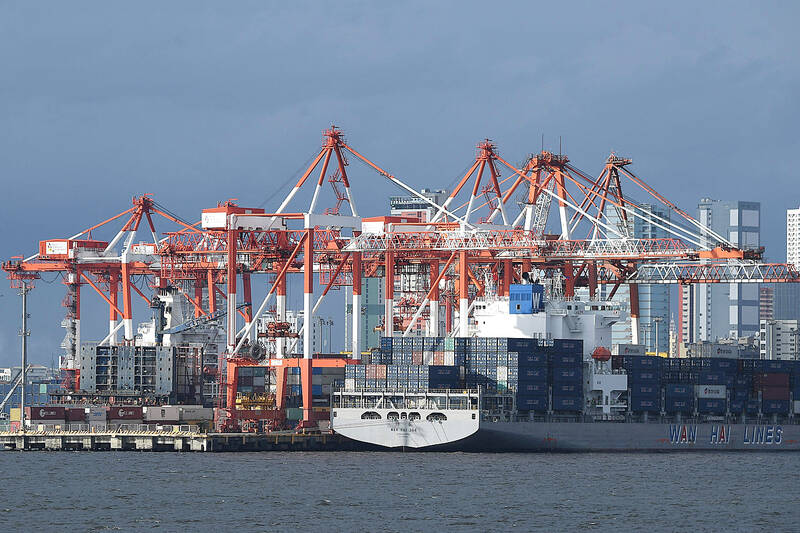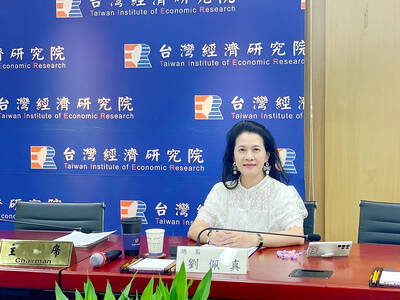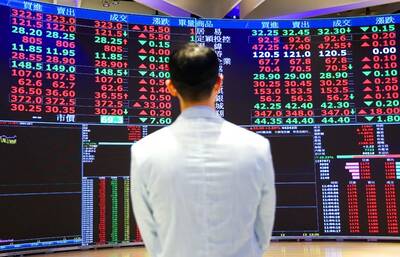The nation’s three major container shipping companies reported rising revenue and profit in the first half of this year on the back of higher freight rates amid ongoing disruptions in the Red Sea, and a better-than-expected rebound in cargo volumes from Asia to the US and Europe, the companies’ regulatory filings released this week showed.
The strong inventory restocking combined with capacity tightness has led to significant increases in freight rates throughout the first half of the year, with analysts expecting this momentum to continue this quarter due to factors such as seasonal cargo demand, port congestions and equipment shortages.
However, rising capacity boosts to the US West Coast, North Europe, Latin America and India in the coming month due to the introduction of more new vessels might limit freight rate growth in the fourth quarter, especially as the off-season approaches, analysts said.

Photo: AFP
Evergreen Marine Corp (長榮海運), the nation’s largest container shipping company in terms of fleet size, posted earnings per share of NT$21.86 in the first six months, far better than Yang Ming Marine Transport Corp’s (陽明海運) NT$6.66 and Wan Hai Lines Ltd’s (萬海航運) NT$5.77.
That came as Evergreen’s net profit increased 362.17 percent year-on-year to NT$46.84 billion (US$1.45 billion) during the January-to-June period, on revenue of NT$194.97 billion, which rose 45.27 percent from the same period a year earlier, the company reported on Tuesday, it said.
Gross margin increased to 28.12 percent, from 21.31 percent a year earlier, it added.
To meet rising operational needs, the company on Tuesday said its wholly-owned subsidiary, Evergreen Marine (Asia) Pte Ltd (長榮亞洲), would lease 223,301 units of containers from Gaining Enterprise SA for up to nine years at a total cost of US$369.62 million.
Yang Ming, the nation’s second-largest container shipper, on Monday reported that its net profit surged 611.28 percent year-on-year to NT$23.27 billion in the first half of the year as revenue jumped 33.87 percent to NT$96.39 billion from a year earlier, while gross margin increased to 27.72 percent from 9.68 percent last year over the same period.
Despite its impressive performance compared with the same period last year, Yang Ming warned that the global economic situation remains precarious amid persistent service inflation, trade tensions and geopolitical conflicts.
In addition, the slowing US economy and the upcoming US presidential election could add further uncertainties on the macroeconomic front, the company said.
Meanwhile, Wan Hai on Monday reported a profit of NT$11.57 billion last quarter, its highest in seven quarters, bringing its net profit in the first half to NT$16.19 billion. It posted net losses of NT$4.46 billion in the same period a year earlier.
First-half revenue grew 31.49 percent to NT$65.78 billion, while gross margin increased to 24.05 percent from minus-4.76 percent a year earlier, the company said.
While the third quarter is the peak season for back-to-school and pre-holiday stocking in Europe and the US, Wan Hai said the market is still full of challenges such as geopolitical tensions, supply chain disruptions and tariff barriers, warranting effective route management and cost control, it added.

IN THE AIR: While most companies said they were committed to North American operations, some added that production and costs would depend on the outcome of a US trade probe Leading local contract electronics makers Wistron Corp (緯創), Quanta Computer Inc (廣達), Inventec Corp (英業達) and Compal Electronics Inc (仁寶) are to maintain their North American expansion plans, despite Washington’s 20 percent tariff on Taiwanese goods. Wistron said it has long maintained a presence in the US, while distributing production across Taiwan, North America, Southeast Asia and Europe. The company is in talks with customers to align capacity with their site preferences, a company official told the Taipei Times by telephone on Friday. The company is still in talks with clients over who would bear the tariff costs, with the outcome pending further

A proposed 100 percent tariff on chip imports announced by US President Donald Trump could shift more of Taiwan’s semiconductor production overseas, a Taiwan Institute of Economic Research (TIER) researcher said yesterday. Trump’s tariff policy will accelerate the global semiconductor industry’s pace to establish roots in the US, leading to higher supply chain costs and ultimately raising prices of consumer electronics and creating uncertainty for future market demand, Arisa Liu (劉佩真) at the institute’s Taiwan Industry Economics Database said in a telephone interview. Trump’s move signals his intention to "restore the glory of the US semiconductor industry," Liu noted, saying that

STILL UNCLEAR: Several aspects of the policy still need to be clarified, such as whether the exemptions would expand to related products, PwC Taiwan warned The TAIEX surged yesterday, led by gains in Taiwan Semiconductor Manufacturing Co (TSMC, 台積電), after US President Donald Trump announced a sweeping 100 percent tariff on imported semiconductors — while exempting companies operating or building plants in the US, which includes TSMC. The benchmark index jumped 556.41 points, or 2.37 percent, to close at 24,003.77, breaching the 24,000-point level and hitting its highest close this year, Taiwan Stock Exchange (TWSE) data showed. TSMC rose NT$55, or 4.89 percent, to close at a record NT$1,180, as the company is already investing heavily in a multibillion-dollar plant in Arizona that led investors to assume

AI: Softbank’s stake increases in Nvidia and TSMC reflect Masayoshi Son’s effort to gain a foothold in key nodes of the AI value chain, from chip design to data infrastructure Softbank Group Corp is building up stakes in Nvidia Corp and Taiwan Semiconductor Manufacturing Co (TSMC, 台積電), the latest reflection of founder Masayoshi Son’s focus on the tools and hardware underpinning artificial intelligence (AI). The Japanese technology investor raised its stake in Nvidia to about US$3 billion by the end of March, up from US$1 billion in the prior quarter, regulatory filings showed. It bought about US$330 million worth of TSMC shares and US$170 million in Oracle Corp, they showed. Softbank’s signature Vision Fund has also monetized almost US$2 billion of public and private assets in the first half of this year,